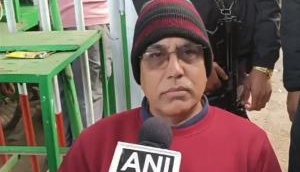From 'Pseudo Secular' to 'Urban Maoist': How Sangh comes up with new phrases for its enemies

Play of words and coining new phrases has come to be the core of Sangh Parivar politics. The Sangh Parivar has invested quite a lot of time and energy over the last over three decades on coining new terms for creating and propagating the 'enemy'. This 'enemy' is anyone who questions the RSS and its affiliates on their propagation of falsehoods and hate. The target has mainly been the liberal and the secular populace of the country.
The trail of the terminology invented to take on the enemy is a long one and is presently concentrated on making the gullible masses accept the new creation of a phenomenon called the 'urban Maoist'. It will be some time when some new term is coined and the emphasis of propaganda is shifted towards it.
This article aims to go back in time to trace this journey of the Sangh Parivar phraseology that first became noticeable when it grew in decibels during the Babri Masjid-Ram Janambhoomi movement of the 1980s.
While the diatribe was always against minorities, particularly Muslims, at that point of time the enemy that was created was described as 'pseudo secular'. The Bharatiya Janata Party (BJP) and the Vishwa Hindu Parishad (VHP) who were spearheading the movement could be heard ranting against 'pseudo seculars' painting them black in every speech that they made while the most derogatory terms were obviously reserved for the Muslims.
Leaders right from Lal Krishna Advani, Murli Manohar Joshi, Uma Bharti and the likes kept on harping about the ills brought to the country by “pseudo seculars”. Among the masses they described pseudo seculars as persons who talked of equality but pandered to the minorities thus playing the game of minority appeasement.
On platforms like the Liberhan Commission that was probing the Babri Mosque demolition they tried to bring out the difference between the 'Nehruvian Secularism' and the traditional western concept of secularism during their deposition. One remembers Advani's deposition where he dwelt at length about the de facto and de jure character of the disputed site while also talking about Huntington's theory of clash of civilisations.
The BJP and its other Sangh Parivar affiliates continued to harp on the “pseudo secular” enemy as their strength grew in the Parliament and the state assemblies in the next one decade.
By the time the Gujarat pogrom against Muslims took place in the aftermath of the 58 Karsewaks being burnt in the Godhra incident the term 'pseudo' was dropped and the foot soldiers on the ground started calling the enemy just secular or secularist. This reporter often came across people underling with confidence, “Gujarat has come out of the shadow of the philosophy of Gandhi (non-violence). Remember one thing the next round of violence will be against the seculars.” Being secular that was referred to 'Bin Sampradayik' in Gujarati had become a dangerous term and openly confessing to being one drew hostilities.
Thereafter, for a brief while there was the usage of the term 'Secular fundamentalist' but for reasons unknown it never became a part of the political narrative of the Hindutva groups.
By the middle of the last decade the internet had started making its presence felt a long way and the BJP started making maximum use of the social media to propagate its ideology. This is something which is envied by people of all the other political parties. The BJP was the first to hire an army of IT professionals who fought a war in the cyberspace. What followed in the era of trolling was new terminologies targeting the liberals and political opponents. These ranged from dubbing the latter as 'Libtard' and 'AAPtard'. In the process the term secular underwent another transformation in Sangh Parivar and became 'Sickular'.
But there was another problem at hand. It was about running down activists who have been opposing the plundering of natural resources and giving a voice to the marginalised tribals in the states that have come to be identified as a part of the Red Corridor, an area under the influence of extreme left or Naxailtes or Maoists. Also there has been a problem in running down the activists talking on behalf of the Dalits. In the first case the activists may or may not have links with the banned Maoist groups or parties.
But the effort visible in the narrative now is to paint everyone questioning the government for its attitude towards the tribals and Dalits as an 'urban Maoist'. It was none other than the Delhi Chief Minister Arvind Kejriwal who first got the nomenclature of an 'urban Naxalite' from the BJP leadership. The phenomenon has been visible with regards to the recent arrest of five activists for the Bhima-Koregaon violence where lines were blurred to dub even Ambedkarites as 'urban Maoists' in the narrative that has flown to the gullible masses. Hence the game of changing terminology in the face of political convenience continues.
Prominent author, dramatist and political commentator Shamsul Islam points out, “They have had to change their terminology from time to time because none of them have sustained and resonated before the masses. In fact, the secular and liberal forces instead of being defensive should ask the Sangh Parivar about their own pseudo nationalism. They should be asked what are they if all others are pseudo seculars, anti-nationals and Maoists.”
He further said, “They should be asked what is your agenda. When you take out a Tiranga Yatra there are hundreds of saffron flags for one tricolour. You are the ones who want to implement Manusmriti in the country and were opposed to the tricolour as the national flag way back in 1947 when the country became independent. Through the Ram Mandir movement and the subsequent communal riots you delivered what fanatic Muslim outfits opposed to Indian unity wanted. You created a divide between the two communities. It will not come as a surprise if every Dalits is dubbed a Maoist. The state can arrest members of the banned Maoist groups or parties but not everyone in the name of Maoism. Maoist thought even forms a part of the curriculum in various universities.”
Eminent political analyst Achyut Yagnik says, “Its an old practice to change the terminology to suit their convenience. During the run up to the 2002 Gujarat assembly elections Narendra Modi was constantly talking about Miyan Musharraf (referring to the Pakistani President General Pervez Musharraf). While 'Miyan' is used as a slur by Sangh Parivar members and supporters in Gujarat Modi would never use the term in Uttar Pradesh where it is an expression of respect and dignity. The same Modi had switched to talking about 'Swarnim Gujarat' five years later while conveniently forgetting 'Miyan Musharraf'. Now the use of term 'urban Maoists' suits them for their politics in the Hindi heartland.”
It is a poll year with both the Lok Sabha and several state elections on the anvil both before and after the parliamentary polls. One can only hope to see several new additions to the Sangh Parivar phraseology in the days to come.







![BJP's Kapil Mishra recreates Shankar Mahadevan’s ‘Breathless’ song to highlight Delhi pollution [WATCH] BJP's Kapil Mishra recreates Shankar Mahadevan’s ‘Breathless’ song to highlight Delhi pollution [WATCH]](https://images.catchnews.com/upload/2022/11/03/kapil-mishra_240884_300x172.png)

![Anupam Kher shares pictures of his toned body on 67th birthday [MUST SEE] Anupam Kher shares pictures of his toned body on 67th birthday [MUST SEE]](https://images.catchnews.com/upload/2022/03/07/Anupam_kher_231145_300x172.jpg)






